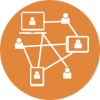The aim of this task is to raise awareness of the digital personal use and how technology may have a disruptive effect. The Visitors and Residents Principle is a guide to assessing a person’s motivation towards the web.
You can learn more by watching this video:
Following this activity, you should be able to:
- be conscious of the amount of time spent online
- map your digital identity as a ‘Visitors’ or ‘Resident’
- plan your own digital diet
Part 1 Background
- Ask students what they think is meant by the term Digital Resident or Digital Visitor. This could be done as part of an online discussion board or as part of their pre-class preparation using a brainstorming tool such as Padlet.
- Ask students whether they consider themselves digital residents or digital visitors for the following online tools:
- Whats app
- Snapchat
- Google Scholar, Google Search and other search engines
- Banking
- VLE
- Onlne shopping
- YouTube
- Tumbler
- Vine
- Discuss whether there are other common tools that students use, and add these to the list.
- Decide which of these tools can act as inhibitors or distract students from their studies and which tools can help enhance their studies (or both).
- Students can use the MindMeister tool to organise these online tools for themselves.
- The following is a short tutorial video to show you how to mapping tool:NOTE: It may be useful to assign a colour or shape to the tools that students find useful for language learning or those that distract from their studies.
-
DIGITAL – LEARNING – CULTURE, thoughts from David White
Part 2 – Mobile technologies
This section looks at mobile technologies and the impact of mobile technology for language learning.
Procedure
- Ask the students to reflect on the time they spend using their smart phones. Use an online brainstorming tool such as padlet to gather information such as:
- How many hours a day your students spend on their mobile phone.
- How many of these hours are spent using social media (Twitter, Facebook, Snapchat, etc)
- How many of the remaining hours are spent using the phone or text messaging
- What other functions or apps are commonly used?
- The teacher suggests that students download an app to track the various tools used on their phone, for discussion in the class the following week.
- Android users: Quality time: Managing your digital diet
- IOS users: https://www.rescuetime.com/
- In the following class, examine the results either in groups or with the class.
- What is the most common apps used?
- Are these apps considered a distraction to student studies or does it help enhance their language learning.
- Compare the number of hours a day to the original time suggested by students. Are there significant differences?
Next steps
Learn more about how technology can enhance or disrupt your studies.

